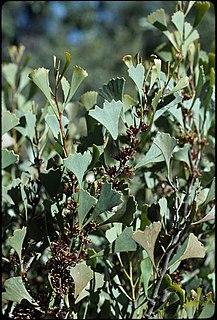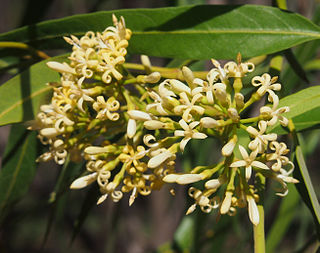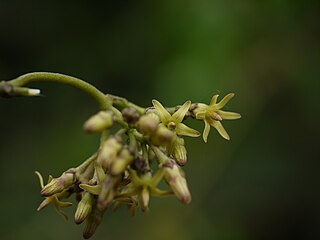
Quercus velutina, the black oak, is a species of oak in the red oak group, native and widespread in eastern and central North America. It is found in all the coastal states from Maine to Texas, inland as far as Michigan, Ontario, Minnesota, Nebraska, Kansas, Oklahoma, and eastern Texas. It is sometimes called the eastern black oak.

Quercus imbricaria, the shingle oak, is a deciduous tree in the red oak group of oaks. It is native primarily to the Midwestern and Upper South regions of North America, from southern New York west to northern Illinois and eastern Kansas, and south to central Alabama and Arkansas. It is most commonly found growing in uplands with good drainage, less often along lowland streams, at 100–700 m altitude.

Parsonsia is a genus of woody vines in the family Apocynaceae. Species occur throughout Indomalaya, Australasia and Melanesia.

Chrysocephalum semipapposum, commonly known as clustered everlasting is a perennial shrub native to Australia. Clustered everlasting belongs to the family Asteraceae. C. semipapposum produces terminal flowers heads in clusters, mainly between spring and early summer with silver-grey appearing stems and branches. It grows up to 40cm high and 60 cm high, although there have been some varieties which can grow up to 1 m. C. semipapposum is often confused as Chrysocephalum apiculatum or 'yellow buttons', due to their similar appearances. C. semipapposum has 4 different subspecies, however they lack distinctive qualities and are often hard to identify. C. semipapposum is endemic to Australia and can be found in multiple states, most notably within Victoria. The plant is found in a variety of habitats including dry rocky regions. Clustered everlasting often grows sparsely and is rarely found in abundance and can be mistaken for a weed. Clustered everlasting has many uses, including as a source of nectar for butterflies, cut flowers or as an addition to a garden.

Parsonsia straminea, commonly known as common silkpod or monkey rope, is a woody vine of the dogbane family, Apocynaceae. It occurs in the states of New South Wales and Queensland in Australia.

Leptospermum lanigerum, commonly known as the woolly teatree, is a small tree or medium shrub from the plant family Myrtaceae. Its common name derives from the conspicuously hairy capsules produced as fruit, along with the fine, silky hairs present on branches and leaves. L. lanigerum is widespread in many habitats, particularly in waterlogged areas such as moist, sandy coastal heaths, on river banks, riparian scrub, woodlands and on the fringe of montane grasslands. This species is endemic to Australia, with native populations occurring in New South Wales, South Australia, Tasmania and Victoria.

Parsonsia brownii, commonly known as twining silkpod or mountain silkpod, is a woody vine of the dogbane family, Apocynaceae. It occurs in rainforest in the states of New South Wales, Victoria and Tasmania in Australia.

Parsonsia capsularis is a climbing plant endemic to New Zealand in the family Apocynaceae.

Ptychosperma elegans, commonly known as the solitaire palm, is a very slender palm endemic to Queensland in Australia. In the nursery trade and in the United States it may be confusingly referred to as Alexander palm, which is an often-used but misnomered name of another Australian palm species Archontophoenix alexandrae, the Alexandra palm.

Tirumala hamata, the ' ' 'Dark tiger' ' ', is a butterfly of the family Nymphalidae. It is distributed from the Philippines to Australia and Pacific oceanic islands such as Samoa. In Australia, the butterflies perform mass migrations to the south in some years. In April 1995, the butterfly made a rare migratory journey to New Zealand, coinciding with the appearance of Hypolimnas bolina on the islands.

Parsonsia howeana is a vigorous twining vine of the family Apocynaceae. It is endemic to Australia’s subtropical Lord Howe Island in the Tasman Sea. It is common in the island's forests at low elevations.

Solidago velutina, the threenerve goldenrod or velvety goldenrod, is a plant species native to Mexico and to the western United States. The species has been found in southwestern Oregon, east to the Black Hills of South Dakota, and as far south as México State in the central part of the Republic of México. It is classified as a member of Subsection Nemorales.

Regelia velutina, the Barrens regelia, is a species of flowering plant in the myrtle family Myrtaceae. It is endemic to the south-west of Western Australia. It is a large shrub with greyish green, velvety leaves and large clusters of brilliant red to orange flowers on the ends of its branches in spring and summer.

Persicaria decipiens, commonly known as slender knotweed, is a species of flowering plant native to Australia and Asia.

Acacia tenuissima, commonly known as narrow-leaved wattle, broom wattle, minyana, slender mulga or slender wattle, is a shrub belonging to the genus Acacia and the subgenus Juliflorae endemic to temperate and tropical areas of Australia. Indigenous Australians the Kurrama peoples know the plant as Janangungu and the Banyjima know it as Murruthurru.

Hakea flabellifolia, commonly known as the fan-leaved hakea or wedge hakea, is a shrub in the family Proteacea. It is endemic to an area along the west coast in the Mid West and Wheatbelt regions of Western Australia.

Conospermum huegelii, commonly known as the slender smokebush, is a plant endemic to Western Australia.

Parsonsia eucalyptophylla, whose common names are gargaloo and monkey vine, is a woody vine in the family Apocynaceae. It is native to the east coast states of Australia.

Parsonsia alboflavescens is a woody vine of the family Apocynaceae, found from tropical and subtropical Asia to Northern Australia. In the Northern Territory of Australia, where it occurs in Arnhem Land, it has been declared "near threatened".

Veronica gracilis is a plant belonging to the family Plantaginaceae, commonly known as slender speedwell. It is a perennial herb with slender branches, variable shaped leaves and small lilac flowers in spring and summer.






















